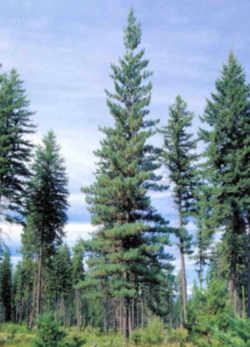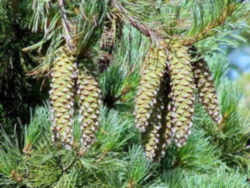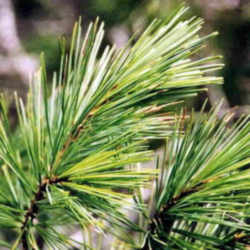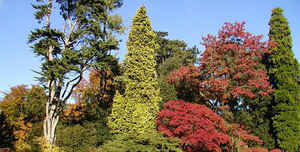Idaho State Tree
Western White Pine

(Pinaceae Pinus monticola)
Adopted on February 13, 1935.
The Western White Pine, (Pinus Monticola pinaceae,) Idaho's state tree, is probably most notable since the largest remaining volume of this timber in the United States grows in the northern part of Idaho. White Pine has many fine qualities such as straight grain and soft even texture. Idaho's state tree grows to 175 feet with a trunk diameter from 5 to 8 feet. The largest western white pine in the world stands 219 ft. high near Elk River, Idaho.
The Western White Pine was adopted by the 1935 legislature as Idaho official state tree. According to the legislative bill, it was promoted by 'members of Ellen Wright Camp, Franklin County Chapter, Daughters of Pioneers.'
Idaho State Tree: Western White Pine

Western white pine, (Pinus monticola,) also called mountain white pine, Idaho white pine, or silver pine, is an important timber tree. The tree extends down to sea level in many areas, particularly in Oregon and Washington. It is the state tree of Idaho, and is sometimes known as the Idaho pine. Its lightweight, non-resinous, straight-grained wood exhibits dimensional stability that makes it particularly valuable for sash, frames, and doors, interior paneling, building construction, match wood, and toothpicks. Western white pine grows rapidly to a large size; one of the largest standing trees measures 200 cm (78.6 in) in d.b.h. and 72.8 m (239 ft) tall in the mountains near Medford, OR.
In Idaho, western white pine occurs almost exclusively in the Northern Rockies Eco-region. Until about 50 years ago, it was the most abundant forest type in that region.

Prior to European settlement, the landscape pattern consisted of large mosaics of many thousands of acres, major portions of which were of a similar age class, a legacy of mixed-severity and large stand-replacement fires. White pine forests of 200 or more years of age were common, but so were newly regenerated small trees and shrubs resulting from recent bums, as were forests of an intermediate age. Data from the Coeur d'Alene Basin indicates stand replacement fires occurred at a given location every 150 to 250 years on the average. Mixed severity fires that killed only part of the stand occurred at about 60 to 85 year intervals. After a long absence of fire, western red cedar, western hemlock, or grand fir-species most tolerant of shade would eventually dominate a site. Prior to fire suppression, these species rarely predominated except on the wettest sites because of their susceptibility to fire. Today, the amount of western white pine is 93 percent less than 40 years ago.
Common Names
California mountain pine, mountain white pine, Idaho white pine, or silver pine.
Identification of the Western White Pine
- Leaf: Acicular, 2 to 4 inches long, fascicles of 5, blue-green with white lines of stomatal bloom on two of the three needle surfaces, persist 3 to 4 years, bundle sheath is deciduous, apex blunt.
- Flower: Monoecious; male cones are small, yellow, and clustered near the tips of branches; female cones are larger, almost round, greenish-pink in color, and clustered near the tips of branches in the upper parts of the crown.
- Fruit: Large cylindrical woody cones, 5 to 12" long, thin and curved. Brown when mature; scales thin and unarmed, typically tipped with globs of white resin; very short stalk.
- Twig: Moderately stout and grayish-brown.
- Bark: Initially thin and grayish-green later becoming up to 2 inches thick, gray to purplish-gray and broken into square or rectangular blocks, not ridged and furrowed. Dark bands commonly encircle the tree where whorls of branches have fallen off.
- Form: Tall, straight, evergreen conifer growing to 180 feet tall and 4 feet in diameter with an open crown, long up-raised branches near the top (horizontal lower down); bole commonly free of branches for half its length.
1935 Idaho Legislation
STATE TREE
Idaho Session Laws, 1935, page 35.
AN ACT, DESIGNATING THE WHITE PINE AS THE STATE TREE OF THE STATE OF IDAHO.
WHEREAS, the members of Ellen Wright Camp, Franklin County Chapter, Daughters of Pioneers, by resolution, have asked that the White Pine be designated
as the state tree of the State of Idaho.
NOW THEREFORE:
Be it Enacted by the Legislature of the State of Idaho:
Section 1. The White Pine (Pinus Monticolae) is hereby designated and declared to be the state tree of the State of Idaho.
Approved February 13, 1935.
Idaho Law
The law designating the White Pine as the official Idaho state tree is found in the Idaho Statutes, Title 67, Chapter 45, Section 67-4504
TITLE 67
STATE GOVERNMENT AND STATE AFFAIRS
CHAPTER 45
67-4504. STATE TREE DESIGNATED. The White Pine (Pinus Monticolae) is hereby designated and declared to be the state tree of the state of Idaho.
Taxonomic Hierarchy: White Pine
Kingdom: Plantae – Plants
Subkingdom: Tracheobionta – Vascular plants
Superdivision: Spermatophyta – Seed plants
Division: Coniferophyta – Conifers
Class: Pinopsida
Order: Pinales
Family: Pinaceae – Pine family
Genus: Pinus L. – pine
Species: Pinus monticola Douglas ex D. Don – western white pine








